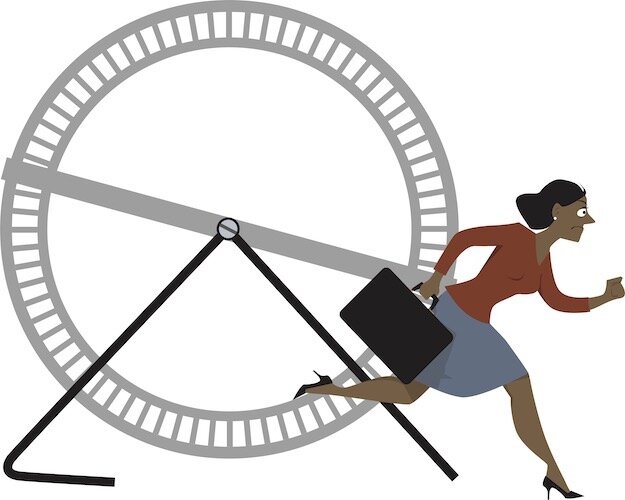People had a chance to think about what they do for work during the COVID-19 work slowdown. They took a look at alternatives. And many of them made changes, a local economist and others say of workers evolving through the pandemic era.
So why does there seem to be a widescale shortage of workers -- so acute that it’s leading some restaurants and retailers to cut their hours and causing some service industry employers and contractors to fall behind on their work orders and miss business opportunities?
“There’s not one cause for this,” says Timothy Bartik, senior economist with the W.E. Upjohn Institute for Employment Research.
He says economists and other pundits are not really sure what’s making it tough for employers to find the workers they need. But he knows workers have the latitude to be a bit choosey in the local job market because they know their labor is in demand. Employers are aware of that, he says, and that affects their decisions as well.
“One of the things to keep in mind,” Bartik says, “is that fundamentally what I think is going on, in the short-term is we have excess labor demand relative to the labor supply that people seem to be wanted to provide.”
But what is causing that?
There’s not anything intrinsically wrong with the positions many workers had previously. Of someone who has left child care work to take a job at a big company, for instance, “They know that there is excess demand in the labor market and some manufacturer is offering a $2,000 (sign-up) bonus,” Bartik says. “It’s not that anything particularly has changed about the child care work. It’s just that because you know that some employers are offering a bonus, you might change your decisions.”
Companies like Pactiv Corp., CFI Transport, United Health Group, Amazon, and Allstate have been offering sign-on bonuses ranging from $1,500 per person and more than $5,000.
Time to be your own boss?
Debi Howe, chairwoman of Southwest Michigan SCORE, says the number of people interested in starting their own businesses and working for themselves was way up since all but non-essential Michigan business were ordered to be temporarily closed last year. Although she was not able to quickly produce comparative numbers for previous years, she says there were 48 new business starts in Southwest Michigan in 2020, creating 211 new jobs.
 Some workers have found they enjoy remote work and don't want to return to the office.Antonio Mitchell, who works with new and developing businesses as the community investment manager for the City of Kalamazoo, says he thinks the COVID lockdown changed a lot of workers’ perspectives.
Some workers have found they enjoy remote work and don't want to return to the office.Antonio Mitchell, who works with new and developing businesses as the community investment manager for the City of Kalamazoo, says he thinks the COVID lockdown changed a lot of workers’ perspectives.“Some people retired,” he says. “Some people changed careers. And some people didn’t go back to work at all.”
He said others apparently have decided there are some lower-wage jobs they simply don’t want to do any longer.
“I think people found out they can live on less than they thought they could (during the pandemic shutdown) and then they changed -- literally their perspectives -- because when you get locked down, you can’t go anyplace,” Mitchell says. “You get a lot of time to think. And I think a lot of people had a perspective that they needed to change if possible.”
Steven Morrow says he thinks the COVID shutdown gave a lot of people the opportunity to jump off the hamster wheel. He describes the employment “hamster wheel” as any job that helps a person make just enough money to pay their bills, but does not afford them the means to get ahead and lead a better life.
The 50-year-old former mortgage financing and automobile financing specialist says that was the case with his 22-year-old niece who was a restaurant server in the spring of 2020. She made $200 in tips some days on a stressful job but feared she was unqualified to land a better job that would match what she was making.
“But the slowdown and unemployment benefits gave her a chance to do that,” he says.
She is now one of two women he knows who have become online entrepreneurs. They buy items at low prices here and resell them online at higher prices in order to turn a profit. One resells all kinds of small things. The other buys T-shirts and warm-weather clothing when those items reach low, end-of-season prices and resells them at a mark-up to people in Texas and other always-warm states where prices for such items are hardly ever out of season.
“I didn’t know what I was going to do,” Morrow says he thought when the pandemic struck.
 Some workers have decided their job is like a hamster wheel and now is the right time to get off.He was working full-time in automobile financing and as a purchaser for a used car dealership in Kalamazoo when that business was forced to close to help prevent the spread of the coronavirus.
Some workers have decided their job is like a hamster wheel and now is the right time to get off.He was working full-time in automobile financing and as a purchaser for a used car dealership in Kalamazoo when that business was forced to close to help prevent the spread of the coronavirus.So Morrow says “I did every kind of gig job,” referring to work as a temporary, on-call, and independent contractor.
“I signed up for every gig job I could get,” he says. Doordash, Uber-Eats, Grubhub Food Delivery, Instacart Grocery delivery, Hire a Driver. He tried all these and other jobs “where you pick the job, you go do the task, you get paid for it, and you move on to the next one.”
“I tried all of them out to see which one I could get to work,” he says. “My theory was if one is not producing, I could move on to the next one. So I didn’t care if I made $30 on each. As long as I made $200 that day, it didn’t matter.”
That worked for him then and continues to work for him now. So he has not returned to work with his former employer. Instead, he has returned to auto sales, opening his own business (Sam Wholesale Auto) as a wholesaler. He buys used cars from auto auctions and car dealers, then sells them at wholesale rates to car retailers. He uses money from his gig jobs to cover the cost of fixing up the cars he buys before he sells them.
“The gig market was great because there were opportunities all over the place,” Morrow says. “And I opened my mind up to try everything. I know that for four months, during the summer months, as things were lightening up, I was going into Wal-Mart building bikes. They were paying me like $15 a bike. Then once I got the hang of it, I could do 10 or 20 bikes in five hours.”
When that work ended, he worked for a company that had contracts with Procter & Gamble.
“So I would go into Wal-Mart or Meijer and I would do Procter & Gamble (product) surveys,” Morrow says. “I would go in and check the product and send it off to Procter & Gamble. That would take me, say, two hours and I would make $60. I would do three in Grand Rapids and three in the three stores here in Kalamazoo and call it a day.”
What else is at play?
Due to the pandemic there is a lower labor supply, Bartik says, because:
• There was a huge increase in people working remotely – And a lot of people like it enough to search out an employer who will let them continue it. “Many workers experienced that (working from home) as equivalent to an increase in their compensation because they were able to work from home. They didn’t have to commute, and they had more flexibility in how they could handle child care,” Bartik says.
He says we’re now in a period of transition where many workers are saying, “‘Well, gee, I like remote work.’ And employers are trying to figure out to what degree can we continue offering remote work options that some workers prefer.”
 Some workers are weighing the price of being exposed to COVID-19 or quitting their job to limit their exposure. He says some workers are reluctant to return to their old job if they can find a new employer who will let them work remotely.
Some workers are weighing the price of being exposed to COVID-19 or quitting their job to limit their exposure. He says some workers are reluctant to return to their old job if they can find a new employer who will let them work remotely.• The risk of COVID still exists – That has meant there are fewer older people in the workforce or people who have medical concerns. Some people retire but return to the workforce to become substitute teachers, school bus drivers, or do other part-time work. Bartik says, “Now they’re saying, ‘I don’t know. I’m retired. I’m a little worried about COVID. I’ve had my vaccinations. But I’m worried about breakthrough infections. So those people might not go back to work.”
• Some people may still be suffering – Some have health issues that preceded COVID or that are ongoing after they contracted it and are recuperating from it.
• Child care is an issue – Child care centers and preschools are having trouble getting people to fill vacancies. That means people looking for a child care slot may be having more difficulty, Bartik says. Schools have also periodically shut down a classroom and quarantined people to prevent the spread of COVID, resulting in the need for more child care. “Some people may be deciding (telling themselves) ‘Ordinarily I’d go back to work. But I’m having trouble finding child care. And in addition, due to COVID, there’s been a shut down of some schools, so maybe I’ll stay home,’” Bartik says.
The unemployment rate for the Kalamazoo metropolitan area was 4.1 percent in September, versus 5.8 percent in September of 2020. In months not affected by a recession-inducing pandemic, that would be considered an improvement. But there were 3,600 fewer workers in the area’s civilian workforce, 162,900 in September of 2021 versus 165,300 in September 2020.
There were slightly more people in manufacturing, 22,200 in September 2021, versus 21,800 the previous year. There were only 200 more workers in the leisure and hospitality industry, the sector that includes restaurants and hotels.
According to the Michigan Department of Technology, Management & Budget, there were also 47.6 percent more job advertisements in the state of Michigan in the third quarter of this year, versus the third quarter of 2020 – 399,500 compared to 270,700. There were 283,400 job advertisements reported in the third quarter of 2019 and there were 388,800 ads placed in the second quarter of this year.
September set a new single-month high for available job openings, according to the state. There were 238,7000 available job advertisements, up 3 percent from the last previous high, 231,800 postings in May of 2021.
 Some workers have found they need to stay home with their children as daycare has become harder to find.Aaron Hilliard, vice president of human resources at Kalamazoo Valley Community College, says the college lost a number of employees last year as workers struggled to find adequate care for their children. He says the community college lost some workers but that created openings that allowed remaining workers to make shifts.
Some workers have found they need to stay home with their children as daycare has become harder to find.Aaron Hilliard, vice president of human resources at Kalamazoo Valley Community College, says the college lost a number of employees last year as workers struggled to find adequate care for their children. He says the community college lost some workers but that created openings that allowed remaining workers to make shifts.He says he thinks COVID resulted in greater consumer demand for goods and that has created more opportunities for people to find other positions.
“I think also there’s a situation where inflation has taken its toll,” he says. “If you’re working 20 hours a week at Burger King or McDonald’s and it costs you more to work than you’re earning at work, then each person has to make those hard decisions (on whether to continue).”
He says some may be taking the opportunity to work a 40-hour-a-week job at a manufacturing operation that offers more stability, structure, and better benefits.
“I think that’s what’s impacting the service jobs out there,” Hilliard says. “There are other employment opportunities for people who would generally fill those service jobs.”
Isabella Soiter says expanded unemployment benefits caused some of her co-workers to limit their working hours after their employer’s restaurant reopened last year. The 19-year-old server says the unemployment benefits were more than some were earning at work and they simply did not return to work. That left the business short-handed. Asked why there seems to be a shortage of workers, particularly in the service industry, she was not sure.
“People just might not want to work,” she says. “People were still getting checks from the government for the unemployment. I think a lot of times it was more than what they were getting at work. So it seems better just to get that.”
 Employers have offered hiring bonuses but so far have resisted bumping up salaries in a big way.
Employers have offered hiring bonuses but so far have resisted bumping up salaries in a big way. Bartik says extended unemployment benefits for COVID-related layoffs and stimulus payments from the federal government have left many Americans in better financial shape than families who worked to recover from past economic recessions. But he says he doesn’t think the COVID-related payments are influencing workers’ decisions now.
Clarice Bryant attributes the shortage of workers at the Farm and Fleet store where she works to COVID and the vaccine mandate. “A lot of people just didn’t agree with it,” the 18-year-old says. “So they quit and went to another place that wouldn’t require it. That sort of thing.”
Jeremiah House, of Kalamazoo, wonders if the overall worker shortage is a result of people returning to school to educate themselves for higher-paying jobs. Or perhaps it’s the simple inaccurate or under-reported data on workers.
Aside from that, he wonders if workers aren’t tired of jobs with long hours, low status, and limited opportunities for advancement.
“Maybe there’s a ceiling (and) there’s not a higher position,” the 28-year-old child care/behavioral technician proposed. “And if so, it’s not worth the stress. Because more responsibility doesn’t always mean a better quality of life. So maybe that’s the issue.”
Why don’t employers attract the workers they need by simply increasing the wages they pay and perhaps the benefits they offer?
“Because employers are not sure how persistent all this will be,” Bartik says. They would be committed to paying higher wages indefinitely if they made an across-the-board increase. “If employers knew for certain that this was going to be persistent – and the labor supply reduction relative to demand was persistent -- maybe they’d raise wages more. But if they’re not sure it’s persistent, they’d say, “I don’t want to raise wages.’”
"some" - Google News
November 19, 2021 at 12:26PM
https://ift.tt/3CwJPAo
Where have all the workers gone? Some Kalamazoo observers offer answers - Concentrate
"some" - Google News
https://ift.tt/37fuoxP
Shoes Man Tutorial
Pos News Update
Meme Update
Korean Entertainment News
Japan News Update
Bagikan Berita Ini















0 Response to "Where have all the workers gone? Some Kalamazoo observers offer answers - Concentrate"
Post a Comment